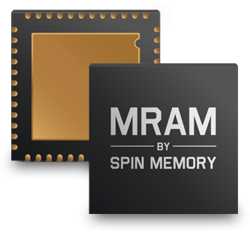Spin Memory Universal Selector Method of Designing Memory to Shake Up $100 Billion Chip Market
Brings DRAM, MRAM and other memories to higher densities than predicted by Moore's law.
This is a Press Release edited by StorageNewsletter.com on August 19, 2020 at 2:15 pmSpin Memory, Inc. announced a solution that will improve the capabilities of existing and emerging memory technologies: the Universal Selector.
As the cost of semiconductor scaling and innovation continues to rise, the industry has struggled to make major advances in scaling and performance – which limits advancements in areas such as AI and IoT.
The Universal Selector creatively solves this problem with a novel approach to how transistors are designed and built into memory chips. It is a new way of designing DRAM, magnetoresistive random-access memory (MRAM), Resistive RAM (ReRAM) and other emerging memory technologies – which encompasses more than $100 billion in semiconductor products. it allows on-chip memory to achieve higher levels of performance, reliability and density than ever before, which will boost innovation to levels above that anticipated by Moore’s Law.
This innovation enables new layouts, smaller cell footprints and improved densities in DRAM, MRAM and ReRAM products – bringing about higher levels of performance, reliability and density than ever before. Additionally, it is the first industry solution to the DRAM problem of row hammer disturbs, while simultaneously reducing Soft Error Rates (SER) and leakage. The company is currently working with NASA on the applicability of this technology to develop low SER and row hammer-immune DRAM solutions.
“Row hammer is one of the leading issues in DRAM reliability and security, and has long been a frustrating plague on the memory industry. As DRAM’s longstanding major disturb problem, row hammering is only becoming more of a problem as cells shrink,” said Charlie Slayman, technical program chair, IRPS 2020. “Spin Memory’s Universal Selector offers a novel way to design vertical cell transistors and has been presented to the JEDEC task group evaluating solutions to the row hammering problem.“
Universal Selector is a selective, vertical epitaxial cell transistor whose channel has a low enough doping concentration that it operates in full depletion. The fully depleted cell transistor along with other unique process and device features leads to a crucial architectural change, allowing the channel to be completely electrically isolated from the silicon substrate. This eliminates the possibility of any trapped or migrating electrons causing row hammer, making this design row hammer-immune.
Beyond solving the row hammer disturb problem, the Universal Selector improves DRAM array density by 20% -35% through its 4F2 DRAM bitcell configuration. For emerging memories such as MRAM, ReRAM and PCRAM, it enables manufacturers to create 1T1R memory bitcells of 6F2 – 10F2 , enabling manufacturers to embed up to 5x more memory in the same area footprint with minimal additional wafer, accessing costs. This improved memory density will fulfill the demands of cutting-edge applications – allowing AI, virtual reality, edge computing and more to reach new technological heights.
“Today’s most innovative and demanding technologies need more advanced memory to keep up with computing demands. Speed and reliability are necessary for complex applications running at the edge, such as autonomous vehicles or health wearables – where accurate and real-time decisions could make the difference between lif and death,” said Tom Sparkman, CEO, Spin Memory. “Our latest breakthrough innovation allows for exciting new advancements and capabilities for these technologies – in addition to pushing MRAM into the mainstream market.“
Beyond the density improvements for DRAM and all emerging memories, the Universal Selector will bring MRAM to a new level of SRAM-like performance. Combined with the company’s other MRAM IPs and innovations, including the PSC, the firm is overcoming all the limitations of MRAM to offer a next-gen nonvolatile memory solution for the industry. The emerging hyper-dense, performance MRAM will offer a new memory option that overcomes many of the limitations of legacy SRAM solutions for on-chip memory.
Additionally, this way of building transistors allows for smaller memory cells while utilizing materials and processes that already exist in standard silicon manufacturing processes. This empowers any developer of non-flash memories to take advantage of the Universal Selector quickly and easily. This breakthroughit allows for improved density for almost every memory technology on the market without requiring an investment in specialized hardware or resources.
The company will share additional technical details on this technology and solution at the virtual 31st Magnetic Recording Conference on Thursday, August 20. Dr. Kadriye Deniz Bozdag, manager, MRAM testing, Spin Memory, will give an online presentation on the Universal Selector’s full functions and capabilities. To register to the presentation online.
Read also:
Spin Memory Extends Series B Funding
Unknown additional investment from all major investors
July 20, 2020 | Press Release















 Subscribe to our free daily newsletter
Subscribe to our free daily newsletter


